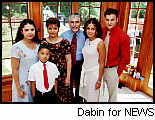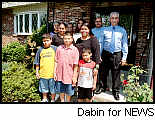|
 |
|
Esta página no está disponible en español. New York Daily News Puerto Ricans Take Road To A Better Life: Middle Class Leaving City For Suburbs By FERNANDA SANTOS, DAILY NEWS STAFF WRITER August 10, 2003 They first tasted suburbia 20 years ago, at a family outing 105 miles south of their home in Bayside, Queens. The summer trips to Cherry Hill, N.J., soon became a tradition for Ed Prez, 56, his wife, Priscilla, 55, and their two daughters - a respite from the hubbub of city life at a place where children could play freely on the streets while parents enjoyed poolside barbecues. After years of trekking down to South Jersey, they started wondering what would it be like to leave New York. What mattered, Ed Prez said, was that life would be cheaper and more manageable in Cherry Hill - and the public schools would be better. "I wanted my kids to go to college, to grow up to be professionals, and the chances were much greater if we got out of New York," said Prez, whose parents immigrated from Ponce, Puerto Rico, to New York in 1946.
In the spring of 1987, Prez, now a project manager for the Latin American Economic Development Association in Camden, N.J., bought a house - the first he had ever owned - and moved his family to Cherry Hill, a middle-class town of 70,000 just outside Philadelphia. Since then, 15 of Prez's relatives from Queens and Brooklyn have followed. Cousin Jaime Garca, 35, his wife, Miriam, 33, and their six children - James, 12; Genesis, 11; Amber, 9; Josiah, 8; Caleb, 6, and Charissa, 4 - moved from a rental apartment in Ridgewood to a house in Cherry Hill in 1995. Two months ago, Prez's niece Michele Gonzlez, 36, her husband, Vincent, 38, their three children and two in-laws sold a house they owned in Red Hook and used the money to buy a three-bedroom Colonial in nearby Lawnside, N.J. The Prezes and their extended family are part of a growing number of middle-class Puerto Rican families who have left New York to settle in suburbs and smaller towns across the U.S. For the first time in history, the number of Puerto Ricans living in the city has decreased, slipping by 107,591 - or 12% - to 789,172 over the past decade, 2000 census data show. The Puerto Rican decline has coincided with a surge in the overall Hispanic population driven mainly by increased immigration from the Dominican Republic, Mexico and Ecuador in the 1990s and high fertility. In the past decade, the number of Latinos grew 21%, to 2.2 million, accounting for 27% of the city's population, according to the census. Middle-class Puerto Ricans move out of New York primarily because they find better schools, a cheaper cost of living and an improved quality of life, according to several families and demographers interviewed by the Daily News. But they are not the only ones to leave. Lower-income families, some of them on public assistance, have been moving out of the city simply because New York has become too expensive. "The gentrification of the city is pushing up prices, so the Puerto Rican poor have no place to go," said Angelo Falcn, a senior policy executive at the Puerto Rican Legal Defense and Education Fund. Massive migration "It's almost like New York City, as important as it is in the history of the Puerto Rican migration in the United States, became a dead end, economically, for many Puerto Ricans," Falcn said. Puerto Ricans have had a presence in New York since the late 1800s, but poverty back home and a closer relationship with the U.S. in the 1930s drove a massive migration out of the island. From 1940 to 1970, the number of Puerto Ricans in the city surged to 817,712 from 61,000 and peaked at 896,763 in 1990. By the late 1950s, many bodega owners, building superintendents, doormen and factory workers in the city were from Puerto Rico. Today, most bodegas are run by Dominicans, the supers and doormen are more likely to be from Albania or Croatia and many of the factories have closed or moved. At 27, Anthony Garcia has come a long way since his days as an unemployed newlywed in Bensonhurst, Brooklyn. Garcia worked for almost two years at New Resina, a foundry in Red Hook, Brooklyn, when he was laid off early in 1997. Six months later, he moved to Lancaster, in the heart of Pennsylvania's Amish country, and in no time found a $6-an-hour job designing display windows at an outlet mall. "I couldn't believe that even though I made so little, I could still rent a nice apartment and pay my bills," said Garcia, whose mother moved from Mayagez, Puerto Rico, to Red Hook in the 1960s. "If I had a job that paid the same in New York," he said, "I'd probably be homeless." Garcia, his wife, Valerie, 27, and their daughters - Ariana, 9, and Kaylin, 5 - live in a $788-a-month townhouse with central air conditioning, a patio and two cars in the garage. Working for better life He toils on the graveyard shift at United Parcel Service, loading delivery trucks and earning twice as much as he did when he arrived. In the afternoons, he takes echocardiography classes at a community college while his wife works as a pediatric nurse. "Everything here is well worth living for," Garcia said. "I open up my windows and see nothing but beautiful green grass and cornfields." Lancaster's Puerto Rican population, the 27th largest in the U.S., increased 33% during the '90s, according to the 2000 census. Collegeville, Pa., experienced the largest percentage growth in the nation - 4,350%. At 178, though, its Puerto Rican population is still insignificant compared with that of nearby Philadelphia, which is home to 91,527 Puerto Ricans, 35% more than in 1990, census data show. "When we talk about the Puerto Rican experience, we have to look at the suburbs and small towns or we won't get the full picture," said Csar Ayala, a professor of sociology at UCLA and an expert on the history of Puerto Rican migration to New York. "It's clear that there is a deconcentration of the Puerto Rican population in big cities, especially New York," he said, "and this is a process that is undoubtedly going to continue." Nationwide, the Puerto Rican population continued to expand, growing 25% to 3.4 million in the past decade. And in New York, despite the migration out, Puerto Ricans continue to maintain their status as the city's largest ethnic group. Florida influx From 1990 to 2000, central Florida saw the largest spike in its Puerto Rican population. The number of Puerto Ricans in Orlando grew by 10,000, or 142%; in the Tampa suburb of Brandon, the increase was 2,921, or 174%, and in Kissimmee, 8,734, or a whopping 339%, according to the 2000 census. "When my daughter had to go through metal detectors in middle school, it freaked me out," said Ray Cruz, 41, who moved his family from Woodhaven, Queens, to the Tampa suburb of Valrico in 1995. "I spent all my life in New York and was never able to buy a home there," said Cruz, whose parents moved from Las Piedras, Puerto Rico, to Brownsville, Brooklyn, in the 1950s. "I bought one here six months after we arrived." Cruz, his wife, Lourdes, and their 10-year-old daughter, Maria, have been to New York only twice since they left - once for a funeral and the other on a vacation that included visits to Yankee Stadium and the Empire State Building. "We would never move back," Cruz said. "It's not that we hate New York, but Florida is home for us. We're really happy here." Urban flight Top 10 cities nationwide with highest percentage increase in Puerto Rican population 1990-2000: 1. Collegeville, Pa. 2. Smiths, Ala.? 3. Saugerties, N.Y.p> 4. Country Club, Fla. 5. Lake in the Hills, Ill. 6. Minneola, Fla. 1,295% 7. Golden Lakes, Fla. 8. Toms River, N.J. 9. Elk Grove, Calif. 10. Concord, N.C. Top 10 cities nationwide with largest Puerto Rican populations 1990-2000: 1. New York City 2. Chicago 3. Philadelphia? 4. Newark 5. Hartford 6. Springfield, Mass. 7. Bridgeport, Conn. 8. Jersey City 9. Boston 10.Cleveland Source: Census Bureau
| |||||||||||||



